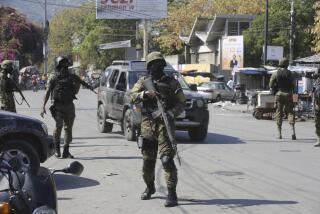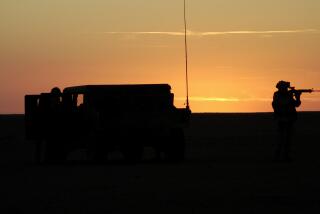Diplomats use role-playing to prepare for duty in Iraq
Sitting helplessly in the back of a bombed armored troop carrier as soldiers scrambled to tend the wounded, the diplomat had to ask himself: Was his meeting with Iraqi officials worth this?
It is a question that instructors at the Army’s National Training Center at Fort Irwin, in the Mojave Desert, hope diplomats always ask themselves before requesting transportation from the military units that house and protect them in many parts of Iraq.
This time, a pyrotechnics crew was responsible for the stomach-churning boom. But soon enough, the explosions, the burns and shattered limbs could be all too real.
Until that moment, it had not occurred to Cris Dilworth that a civilian could put armed soldiers in harm’s way.
“It was a strange thought,” the bearded diplomat said the next morning over weak coffee and powdered eggs in the mess tent.
For career diplomats, Iraq is an unusual assignment. Other than Afghanistan, no mission requires the same degree of cooperation between diplomats and service members. For the first time, they are getting a chance to train together before meeting in a combat zone.
Dilworth, who processed immigrant visas in Egypt before volunteering for a political post in Baghdad, and three other diplomats headed to their first assignments in Iraq recently joined the Army’s 3rd Stryker Brigade Combat Team, 2nd Infantry Division for a week of intense role-playing at Fort Irwin. The diplomats slept on cots and worked out of a tent on a base surrounded by re-created Iraqi villages. Each day, they strapped on flak vests over their business jackets and clambered into armored carriers to meet with local leaders, played by Iraqi immigrants. They confronted insurgent attacks, corrupt officials and sectarian rivalries.
“You can forget at times that you are in California,” said Wesley Robertson, a public diplomacy officer who is trading a post in Chennai, India, for Iraq’s violent Diyala province.
All four diplomats are joining Provincial Reconstruction Teams, or PRTs. These civilian-led teams, which include some military officers and representatives of other government agencies, were conceived in 2005 to help Iraq’s local and provincial governments provide services, promote stability and stimulate development.
The State Department provides its PRT members with three weeks of classroom instruction, covering personal safety and job basics. But once in Iraq, members found that precious months were wasted as they learned to operate in a combat environment and to work alongside the military, whose structure and culture was different from their own, said Les Garrison, a reconstruction team veteran working as a trainer at Fort Irwin.
Tempers sometimes flared when PRT members would make last-minute requests for transportation, not realizing the preparation required to ensure the safety of each trip, or when the military would arrest a local leader the PRT had been cultivating.
The training, which for now is optional for State Department employees, emphasizes the need for both sides to agree on political and economic goals for a province. Although the military and teams both have development funds to spend, their priorities are often different. The military looks for projects that can have a quick effect to wean communities from the insurgency, Garrison said. PRTs tend to take a more long-term view.
“By the end of three months in Iraq, most everybody has their attitudes changed,” Garrison said. “But we are really increasing the effectiveness of the brigade and the PRT in the first three months.”
For the military, incorporating civilians into combat training is part of an effort to introduce service members to the growing number of government agencies represented in Iraq and the skills they bring.
The first class of diplomats used the long hours spent bouncing around in the back of a vehicle to get to know some of the young soldiers and were struck by how experienced they were. Although still in their 20s, many were headed to their second or third deployments in Iraq.
George Tietjen, a former Marine, was already familiar with military rank and jargon. But the others said it took them most of the week to figure out who does what in a brigade, and how they might help one another.
“There are four of us and there are 4,000 of them, so I compare it to a language-immersion program,” said Tietjen, who was deputy regional security officer in Egypt when he volunteered for a political and economic post in the central Iraqi city of Ramadi.
One of the key discoveries, he said, was the importance of the PowerPoint presentation in communicating an issue to their military colleagues. Every piece of information officers presented at their meetings had an accompanying slide.
“If we are bridging the cultural gap, at a minimum, we should have our own slide,” Tietjen said.
For Carol Hanlon, who joined the State Department after a long career in international mergers and acquisitions, it was reassuring to try out living on a base before settling into one for a year. She learned to wake up at dawn to get to the field showers before the hot water ran out. And she made a note to pack a mirror -- there were none to be found.
“We are going to a dangerous place and it’s a huge job,” said Hanlon, a political officer in Australia who was headed to the southern Iraqi city of Karbala. “Just to have this experience out of the way is one less thing to worry about.”
--
More to Read
Sign up for Essential California
The most important California stories and recommendations in your inbox every morning.
You may occasionally receive promotional content from the Los Angeles Times.










